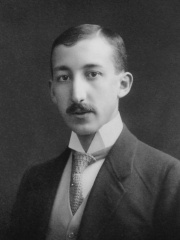
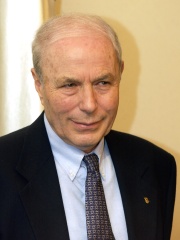
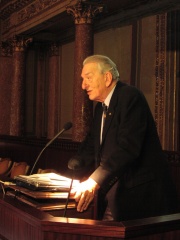
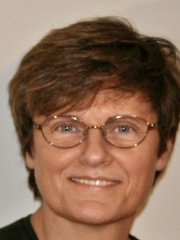
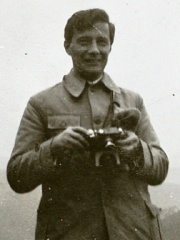
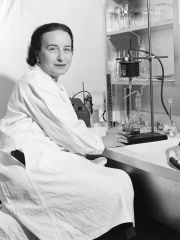
The Most Famous
CHEMISTS from Hungary
Top 7
The following people are considered by Pantheon to be the most legendary Hungarian Chemists of all time. This list of famous Hungarian Chemists is sorted by HPI (Historical Popularity Index), a metric that aggregates information on a biography's online popularity.

1. George de Hevesy (1885 - 1966)
With an HPI of 73.47, George de Hevesy is the most famous Hungarian Chemist. His biography has been translated into 62 different languages on wikipedia.
George Charles de Hevesy (born György Bischitz; Hungarian: Hevesy György Károly; German: Georg Karl von Hevesy; 1 August 1885 – 5 July 1966) was a Hungarian radiochemist and Nobel Prize in Chemistry laureate, recognized in 1943 for his key role in the development of radioactive tracers to study chemical processes such as in the metabolism of animals. He also co-discovered the element hafnium.

2. Avram Hershko (b. 1937)
With an HPI of 73.09, Avram Hershko is the 2nd most famous Hungarian Chemist. His biography has been translated into 56 different languages.
Avram Hershko (Hebrew: אברהם הרשקו, romanized: Avraham Hershko, Hungarian: Herskó Ferenc Ábrahám; born December 31, 1937) is a Hungarian-born Israeli biochemist who received the Nobel Prize in Chemistry in 2004.

3. George Andrew Olah (1927 - 2017)
With an HPI of 72.47, George Andrew Olah is the 3rd most famous Hungarian Chemist. His biography has been translated into 57 different languages.
George Andrew Olah (born Oláh András György; May 22, 1927 – March 8, 2017) was a Hungarian-American chemist. His research involved the generation and reactivity of carbocations via superacids. For this research, Olah was awarded a Nobel Prize in Chemistry in 1994 "for his contribution to carbocation chemistry." He was also awarded the Priestley Medal, the highest honor granted by the American Chemical Society and F.A. Cotton Medal for Excellence in Chemical Research of the American Chemical Society in 1996. After the Hungarian Revolution of 1956, he immigrated to the United Kingdom, which he left for Canada in 1964, finally resettling in the United States in 1965. According to György Marx, he was one of The Martians.

4. Katalin Karikó (b. 1955)
With an HPI of 71.31, Katalin Karikó is the 4th most famous Hungarian Chemist. Her biography has been translated into 59 different languages.
Katalin "Kati" Karikó (Hungarian: Karikó Katalin, pronounced [ˈkɒrikoː ˌkɒtɒlin]; born 17 January 1955) is a Hungarian-American biochemist who specializes in ribonucleic acid (RNA)-mediated mechanisms, particularly in vitro-transcribed messenger RNA (mRNA) for protein replacement therapy. Karikó laid the scientific groundwork for mRNA vaccines, overcoming major obstacles and skepticism in the scientific community. Karikó received the Nobel Prize in Physiology or Medicine in 2023 for her work, along with American immunologist Drew Weissman. Karikó co-founded and was CEO of RNARx from 2006 to 2013. From 2013 to 2022, she was associated with BioNTech RNA Pharmaceuticals, first as a vice president and promoted to senior vice president in 2019. In 2022, she left BioNTech to devote more time to research. In 2021, she received an honorary doctorate from the University of Szeged in Hungary, where she has since become a professor. While Karikó has also been associated with the University of Pennsylvania, which would benefit financially from her eventual discovery, the university had actively discouraged her from pursuing research by underfunding and deprioritizing work on mRNA. After being demoted by the University of Pennsylvania in 1995, Karikó was never granted tenure and joined BioNTech in 2013 after the university had declined to reinstate her. Karikó's work includes scientific research on RNA-mediated immune activation, resulting in the co-discovery with Drew Weissman of the nucleoside modifications that suppress the immunogenicity of RNA. This is seen as a further contribution to the therapeutic use of mRNA. Together with Weissman, she holds United States patents for the application of non-immunogenic, nucleoside-modified RNA. This technology has been licensed by BioNTech and Moderna to develop their protein replacement technologies, but it was also used for their COVID-19 vaccines. The messenger RNA-based technology developed by Karikó and the two most effective vaccines based on it, BioNTech/Pfizer and Moderna, have formed the basis for the effective and successful fight against SARS-CoV-2 virus worldwide and have contributed significantly to the containment of the COVID-19 pandemic. For their work, Karikó and Weissman have received numerous other awards besides the Nobel, including the Lasker–DeBakey Clinical Medical Research Award, Time Magazine's Hero of the Year 2021, and the Tang Prize Award in Biopharmaceutical Science in 2022.
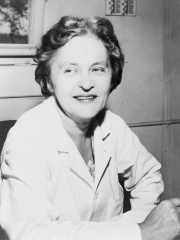
5. Mária Telkes (1900 - 1995)
With an HPI of 67.44, Mária Telkes is the 5th most famous Hungarian Chemist. Her biography has been translated into 41 different languages.
Mária Telkes (December 12, 1900 – December 2, 1995) was a Hungarian-American biophysicist, engineer, and inventor who worked on solar energy technologies. She moved to the United States in 1925 to work as a biophysicist. She became an American citizen in 1937 and started work at the Massachusetts Institute of Technology (MIT) to create practical uses of solar energy in 1939. During World War II, she developed a solar water distillation device, deployed at the end of the war, which saved the lives of downed airmen and torpedoed sailors. Her goal was to create a version for villagers in poor and arid regions. Telkes, often called by colleagues The Sun Queen, is considered one of the founders of solar thermal storage systems. After the war, she became an associate research professor at MIT. In the 1940s she and architect Eleanor Raymond created one of the first solar-heated houses, Dover Sun House, by storing energy each day. In 1953 they created a solar oven for people at various latitudes that could be used by children. In 1952, Telkes became the first recipient of the Society of Women Engineers Achievement Award. She was awarded a lifetime achievement award from the National Academy of Sciences, subsequently receiving a Building Research Advisory Board Award in 1977. Telkes registered more than 20 patents.

6. Michael Polanyi (1891 - 1976)
With an HPI of 65.89, Michael Polanyi is the 6th most famous Hungarian Chemist. His biography has been translated into 36 different languages.
Michael Polanyi ( poh-LAN-yee; Hungarian: Polányi Mihály; 11 March 1891 – 22 February 1976) was a Hungarian-British polymath, who made important theoretical contributions to physical chemistry, economics, and philosophy. He argued that positivism is a false account of knowing. His wide-ranging research in physical science included chemical kinetics, x-ray diffraction, and adsorption of gases. He pioneered the theory of fibre diffraction analysis in 1921, and the dislocation theory of plastic deformation of ductile metals and other materials in 1934. He emigrated to Germany, in 1926 becoming a chemistry professor at the Kaiser Wilhelm Institute in Berlin, and then in 1933 to England, becoming first a chemistry professor, and then a social sciences professor at the University of Manchester. Two of his students won the Nobel Prize, as did his son. In 1944 Polanyi was elected to the Royal Society. The contributions which Polanyi made to the social sciences include the concept of a polycentric spontaneous order and his rejection of a value neutral conception of liberty. They were developed in the context of his opposition to central planning.

7. Elizabeth Roboz Einstein (1904 - 1995)
With an HPI of 56.99, Elizabeth Roboz Einstein is the 7th most famous Hungarian Chemist. Her biography has been translated into 17 different languages.
Elizabeth Roboz-Einstein (April 11, 1904 – January 9, 1995) was a biochemist and neuroscientist known for purifying and characterizing myelin basic protein (MBP), investigating its potential role in the neurodegenerative disease multiple sclerosis (MS), and helping pioneer the field of neurochemistry.
People
Pantheon has 7 people classified as Hungarian chemists born between 1885 and 1955. Of these 7, 2 (28.57%) of them are still alive today. The most famous living Hungarian chemists include Avram Hershko, and Katalin Karikó. The most famous deceased Hungarian chemists include George de Hevesy, George Andrew Olah, and Mária Telkes.
Living Hungarian Chemists
Go to all RankingsDeceased Hungarian Chemists
Go to all RankingsGeorge de Hevesy
1885 - 1966
HPI: 73.47
George Andrew Olah
1927 - 2017
HPI: 72.47
Mária Telkes
1900 - 1995
HPI: 67.44
Michael Polanyi
1891 - 1976
HPI: 65.89
Elizabeth Roboz Einstein
1904 - 1995
HPI: 56.99
Overlapping Lives
Which Chemists were alive at the same time? This visualization shows the lifespans of the 5 most globally memorable Chemists since 1700.

